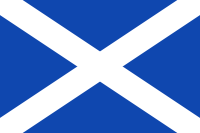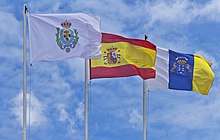
The Canary Islands, also known informally as the Canaries, are a Spanish autonomous community and archipelago in Macaronesia in the Atlantic Ocean. At their closest point to the African mainland, they are 100 kilometres west of Morocco and the Western Sahara. They are the southernmost of the autonomous communities of Spain. The islands have a population of 2.2 million people and are the most populous special territory of the European Union.

The Province of Las Palmas is a province of Spain, consisting of the eastern part of the autonomous community of the Canary Islands. Las Palmas de Gran Canaria, capital city of this province and of the island of Gran Canaria, is the largest city in the Canary Islands.
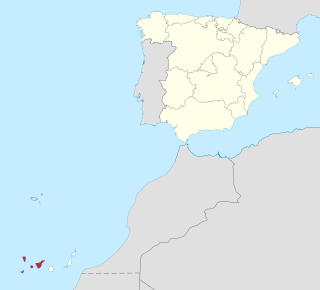
Province of Santa Cruz de Tenerife, also Province of Santa Cruz, is a province of Spain, consisting of the western part of the autonomous community of the Canary Islands. It consists of about half of the Atlantic archipelago: the islands of Tenerife, La Gomera, El Hierro, and La Palma. It occupies an area of 3,381 km2 (1,305 sq mi). It also includes a series of adjacent roques.

Gran Canaria, also Grand Canary Island, is the third-largest and second-most-populous island of the Canary Islands, an archipelago off the Atlantic coast of Northwest Africa and is part of Spain. As of 2023 the island had a population of 862,893 that constitutes approximately 40% of the population of the archipelago. Las Palmas de Gran Canaria, the capital of the island, is the biggest city of the Canary Islands and the ninth of Spain.

Tenerife is the largest and most populous island of the Canary Islands. It is home to 42.9% of the total population of the archipelago. With a land area of 2,034.38 square kilometres (785.48 sq mi) and a population of 948,815 inhabitants as of January 2023, it is also the most populous island of Spain and of Macaronesia.

Santa Cruz de Tenerife, commonly abbreviated as Santa Cruz, is a city, the capital of the island of Tenerife, Province of Santa Cruz de Tenerife, and one of the capitals of the Canary Islands, along with Las Palmas. Santa Cruz has a population of 206,593 (2013) within its administrative limits. The urban zone of Santa Cruz extends beyond the city limits with a population of 507,306 and 538,000 within urban area. It is the second largest city in the Canary Islands and the main city on the island of Tenerife, with nearly half of the island's population living in or around it.

Santa María de Guía de Gran Canaria is a town and a municipality in Las Palmas province of the Canary Islands. It is located on the north side of Gran Canaria island. Its population is 13,811 (2013), and the area is 42.59 km2 (16.44 sq mi).
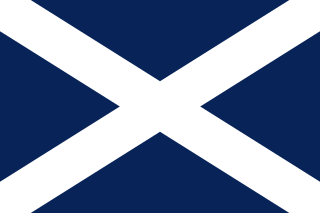
The flag of Tenerife is a white saltire over a blue field. The arms of the cross are approximately one fifth the width of the flag and the field is navy blue.
Televisión Canaria is a Spanish regional free-to-air television network in the Canary Islands belonging to the regional public broadcaster Radio Televisión Canaria (RTVC). It has two production centers in Las Palmas and Santa Cruz de Tenerife, and has offices in the rest of the Canary Islands, as well as in Madrid.
The Canary Islands are an archipelago, or island chain, in the Macaronesia region of the Atlantic Ocean off the coast of North Africa. They are one of 17 autonomous communities of Spain. The demographics of the Canary Islands are concentrated in the largest islands of Tenerife and Gran Canaria.
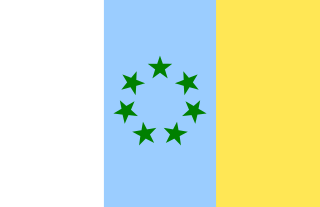
The Movement for the Self-Determination and Independence of the Canary Islands, was an independentist organization and socialist nature, founded in 1964 by Antonio Cubillo, whose objective was the secession of the Canary Islands from Spain. During the 1970s it operated through two terrorist groups: the Guanche Armed Forces (FAG) and the Canarian Armed Detachments (DAC), directly, but unintentionally causing one death, and indirectly causing 583 deaths and 61 injuries. It maintained good relations with other groups terrorists, mainly First of October Anti-Fascist Resistance Groups (GRAPO), who provided it with weapons and explosives, and with socialist Arab governments, such as Libya and Algeria, which provided financing and in Algiers they had a radio station. Also MPAIAC radio programs asked the Canarian people to "return to their roots" and tried to popularize the Berber language.
Spain has many coats of arms: the nation has one, the reigning monarch and the heir presumptive each have one, and there are others for the institutions of state and for Spanish regions and towns.

Canarian nationalism is a political movement that encourages the national consciousness of the Canarian people. The term includes several ideological trends, ranging from a demand for further autonomy within Spain to the right to self-determination.
The Canary Islands derby is any football match contested between Spanish sides UD Las Palmas and CD Tenerife, who are regarded as the top two sides in the Canary Islands. World Soccer Magazine rated it as one of the 50 greatest rivalries in the world, and it is considered one of the most important derbies in Spain.
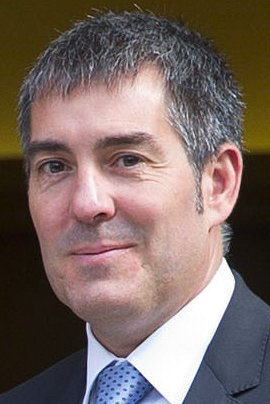
The 2015 Canarian regional election was held on Sunday, 24 May 2015, to elect the 9th Parliament of the Autonomous Community of the Canary Islands. All 60 seats in the Parliament were up for election. The election was held simultaneously with regional elections in twelve other autonomous communities and local elections all throughout Spain.
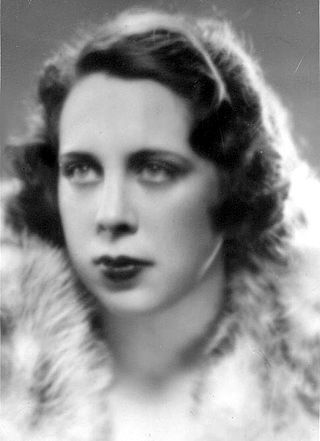
Dolores de la Torre Champsaur, better known as Lola de la Torre, was a Canarian musician and pioneer of musicology in the Canary Islands.
Elizabeth Murray, born Elizabeth Heaphy, was a British watercolourist. She primarily painted portraits and landscapes of the Canary Islands, where she lived for ten years. She was a member of the Royal Institute of Painters in Water Colours, and was one of the founders of The Society of Female Artists in London in 1857.
As in the rest of Spain, the majority religion in the Canary Islands is the Catholic Church. The Catholic religion has been the majority since the Conquest of the Canary Islands in the fifteenth century. This religion would largely replace the Canarian aboriginal religion through the prohibition of the latter and syncretism. According to a survey conducted in 2019, Canary Islands is the fifth autonomous community in Spain with the highest percentage of people who declare themselves to be Catholics after the Region of Murcia, Extremadura, Galicia, Aragon, and Castile and León. 76.7% of the population is Catholic.

The Canarian Football Federation is the football association responsible for all competitions of any form of football developed in the Canary Islands. It is integrated into the Royal Spanish Football Federation and its headquarters are located in Santa Cruz de Tenerife.
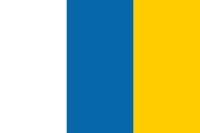
 Flag of the Autonomous Community of the Canary Islands. Flag ratio: 2:3
Flag of the Autonomous Community of the Canary Islands. Flag ratio: 2:3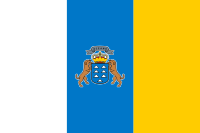
 Flag of the Autonomous Community of the Canary Islands with coat of arms. Flag ratio: 2:3
Flag of the Autonomous Community of the Canary Islands with coat of arms. Flag ratio: 2:3